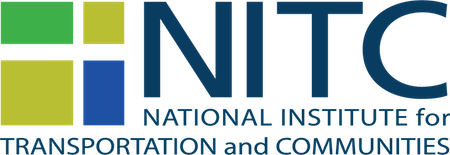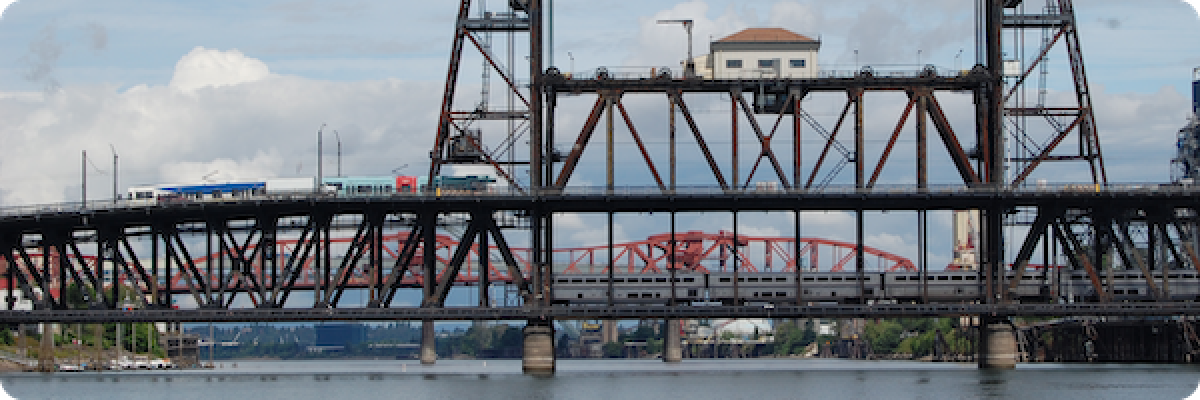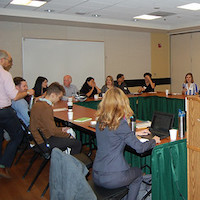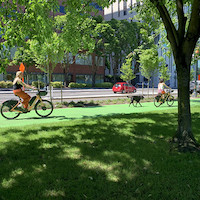Recent decades have seen an increase in catastrophic environmental events that trigger concern for resiliency in our communities, the built environment, and transportation systems. Transportation professionals need to understand how to prepare, respond and recover from these events, and adapt to mitigate the impacts. Download the full literature review of NITC research in transportation resiliency here, or you can download our two-page summary here.
In a series of NITC Research Roadmaps, we surveyed a decade of contributions across six areas of transportation research funded by the National Institute for Transportation and Communities (NITC).
Disaster Phases: Preparation, Recovery, and Long-Term Resiliency
Our studies focus on the preparedness and response phases of a disaster, as well as recovery, mitigation, and adaptation. The studies in preparedness and response focus on engineering assessments for rapid response or mobility and access in the post-disaster moment. Studies on mitigation, recovery and adaptation covered a broad range of topics: from seismic retrofitting of transportation infrastructure to climate action planning in transportation agencies. Case studies on long-term post-disaster recovery are an opportunity for future NITC work to increase resiliency in transportation systems.
Transportation Infrastructure
About a third of NITC's work in resiliency has focused on the engineering and maintenance of transportation infrastructure in the face of environmental change. One study prioritized the retrofitting of highway bridges in Oregon based on their seismic vulnerability, determining which needed to be retrofitted soonest. NITC funding has also supported diversifying the workforce by funding university student researchers and providing the unique opportunity to learn technical skills that are desperately needed by local consultants in the Pacific Northwest, such as assessing the liquefaction potential of regional soils and effects on bridge foundations.
Planning Support Tools
NITC research produces decision-making tools to support evidence-based transportation resilience engineering, planning and policymaking. Several studies have assessed the performance of structures (such as bridges, culverts and highways) during hazard events like earthquakes, flooding, and wildfires. Others have focused on different aspects of the transportation system, such as governance needs and supply chain management. One team of NITC researchers published Rethinking Streets During COVID-19, a book in a series of three on repurposing street space to better meet community needs. This edition compiles examples of street improvements from cities across the U.S., to help planners and engineers, local elected officials, and other city staff visualize how other communities responded to travel changes brought about by the COVID-19 pandemic and related lockdowns.
Mobility and Accessibility
In the aftermath of hazard events, improving mobility and access to services is one of the first priorities to help a community recover. NITC research has improved our understanding of how communities respond to hazards; not only physical disasters like earthquakes, fires and floods, but also public health events like the COVID-19 pandemic. One study examined how households acquired food and other necessities during the first two years of the pandemic, and identified the most common barriers faced by vulnerable subgroups, which include lack of access to a credit or debit card, smartphones, internet, a secure place to receive deliveries, and to a vehicle.
The climate crisis is another focus of transportation resiliency research, and NITC researchers have begun to examine how infrastructure can impact public health as global temperatures rise. With road pavement being a known contributor to the urban "heat island" effect, one NITC study is evaluating a pilot program in Tucson, Arizona where the city is applying engineered pavement coatings to reflect light and reduce the thermal load of roads. The same study also investigated the public health consequences of drive-through COVID-19 vaccination sites, where people spent many hours waiting in line in a high heat-risk environment with idling vehicles.
Governance and Policy
The NITC community has used survey and qualitative approaches to enhance our understanding of governance and policymaking in transportation resiliency. One study worked with local agencies in Salt Lake City to develop a collaborative university/community framework that can help small and medium-sized enterprises recover from supply chain disruptions after an earthquake. They surveyed 130 local businesses within the top 10 worst-affected industrial sectors in Utah to understand how they navigated supply chain disruptions. They investigated how universities and local governments could support their efforts, in order to promote collaborative resilience planning. The exchange of ideas between policymakers and administrators in other regions promotes cross-learning, which helps to establish policies for resilient transportation systems.
Equity and Justice
Environmental change events can have a heavily disproportionate impact on low income, socially vulnerable, and otherwise marginalized community groups. While many resiliency studies mention or address equity in some measure, fewer have equity as their primary focus. One study conducted a flood vulnerability assessment with special reference to low-income and minority neighborhoods in Tucson, Arizona. The research team identified priority locations for Tucson to make transportation improvement investments for the purpose of mitigating urban transportation system flooding where it is needed most. They found that building comprehensive neighborhood-scale green infrastructure in the right-of-way is effective at increasing multimodal access in moderate flooding conditions. Another project developed a new accessibility measure to support older adults in the post-pandemic world, identifying and quantifying the unique challenges faced by older people to help decision makers integrate equity into future policy frameworks.
It’s important to note that this literature review reveals a lack of research emphasis on the intersection of equity and transportation resiliency across all university transportation centers (UTCs). This is a major blind spot and needs to be critically addressed in future research.
Conclusion
The recently passed Infrastructure Investment and Jobs Act (2022) and the Justice40 Initiative present significant opportunities to improve resilience in our transportation systems, and consequently in our communities. What is needed now is actionable research that allows transportation planners and policymakers to make sound, evidence-based decisions on resiliency both quickly and confidently. NITC research has made contributions to this goal by engaging multiple disciplines, bringing together diverse communities of practice, and bridging the research-practice divide. Researchers at the six NITC partner universities have undertaken numerous studies funded by other organizations in the area of transportation resiliency, and are poised to apply that expertise to future NITC-funded research.
What are the impacts of our research on increasing the resiliency in transportation infrastructure? Learn more about some impact stories below.


 Road pavement is a known contributor to the urban heat island effect. Several vendors are providing engineered pavements coatings – known as “cool pavement” - to reflect light and therefore heat to reduce the thermal load of roads. The City of Tucson implemented a pilot application of a 1.5 mile section of cool pavement in Fall 2021 as a part of its Parks and Connections Bond work. Our team of NITC researchers from University of Arizona have been working with the city and vendors to evaluate the treatment and impact on cooler ambient air temperatures. They're also examining whether innovations such as cooler pavement surfaces can make walking and biking more tolerable and extend the life of streets and roads. Few of these cool pavements have been evaluated outside lab conditions, particularly in the desert southwest.
Road pavement is a known contributor to the urban heat island effect. Several vendors are providing engineered pavements coatings – known as “cool pavement” - to reflect light and therefore heat to reduce the thermal load of roads. The City of Tucson implemented a pilot application of a 1.5 mile section of cool pavement in Fall 2021 as a part of its Parks and Connections Bond work. Our team of NITC researchers from University of Arizona have been working with the city and vendors to evaluate the treatment and impact on cooler ambient air temperatures. They're also examining whether innovations such as cooler pavement surfaces can make walking and biking more tolerable and extend the life of streets and roads. Few of these cool pavements have been evaluated outside lab conditions, particularly in the desert southwest. Transportation systems play a critical role in maintaining supply chains for effective post-disaster recovery. Modeling the potential economic impact of transportation-related disruptions is an important step to promoting pre-event community-wide recovery and resilience planning. But existing supply chain and economic impact models are cost prohibitive and overly sophisticated for public sector entities with limited resources. There is also limited understanding of how small and medium enterprises adjust to post-disaster transportation disruption and how this experience influences their future preparedness for similar events. Divya Chandrasekhar of University of Utah has developed a collaborative framework for supply chain and economic impact assessments, and guidance on how to transfer this framework to other communities.
Transportation systems play a critical role in maintaining supply chains for effective post-disaster recovery. Modeling the potential economic impact of transportation-related disruptions is an important step to promoting pre-event community-wide recovery and resilience planning. But existing supply chain and economic impact models are cost prohibitive and overly sophisticated for public sector entities with limited resources. There is also limited understanding of how small and medium enterprises adjust to post-disaster transportation disruption and how this experience influences their future preparedness for similar events. Divya Chandrasekhar of University of Utah has developed a collaborative framework for supply chain and economic impact assessments, and guidance on how to transfer this framework to other communities. The
The 

